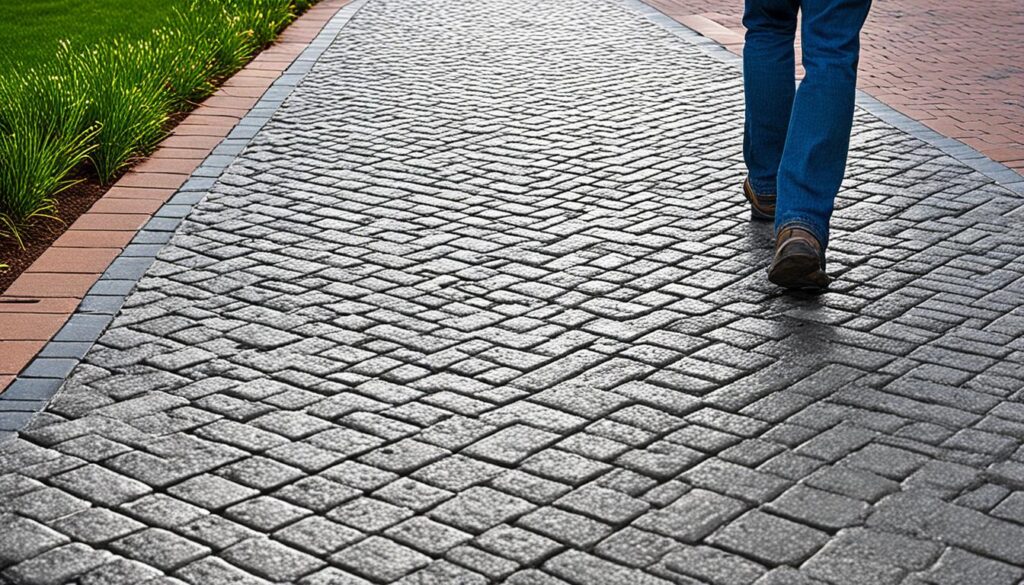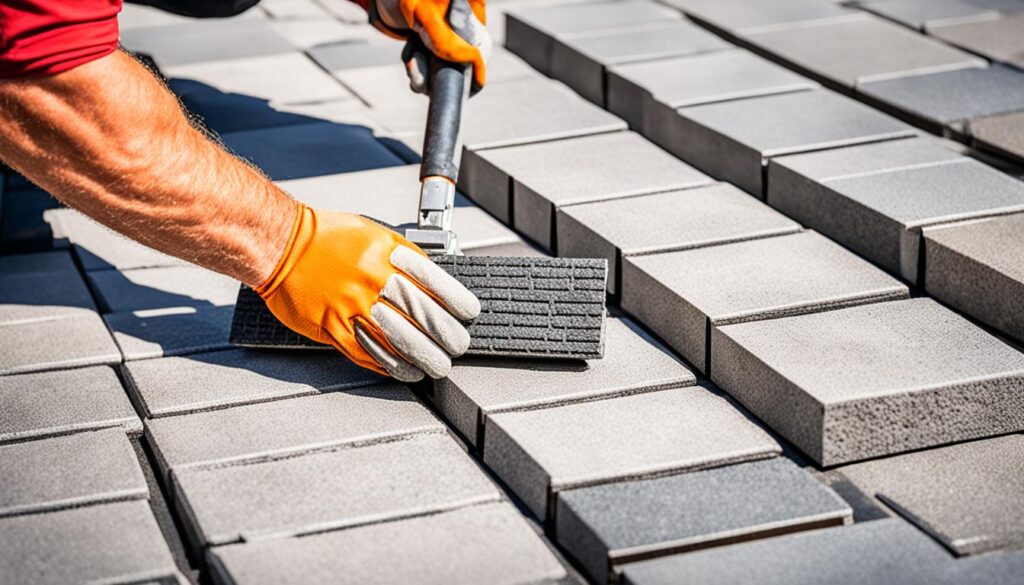
In busy cities, keeping people safe is a top priority. Slip-resistant pavers are a great way to make areas safer. They help prevent slips and falls, making people feel more secure.
These pavers are perfect for sidewalks and pool decks. Their textured surface prevents feet from slipping, even when they’re wet, making outdoor spaces safer for everyone.
It’s important to pick the right pavers for different places. There are many types of slip-resistant pavers, each designed for a specific area. Whether it’s a busy shopping area or a cozy backyard patio, you can find pavers that look good and keep people safe.
Key Takeaways
- Slip-resistant pavers enhance safety in high-traffic areas
- Non-slip surfaces reduce accidents and boost pedestrian confidence
- Textured pavers provide grip in wet conditions
- Anti-skid surfaces are crucial for various outdoor settings
- Different paver types suit specific environments
Understanding Slip-Resistant Pavers and Their Importance
Slip-resistant pavers are key to making walkways safe. They boost paver traction, making them vital for places with lots of foot traffic. Let’s dive into what they are and why they’re important.
What are slip-resistant pavers?
These pavers have textured surfaces to increase friction. They’re made from materials like concrete, stone, or rubber. The special patterns on their surfaces prevent slipping and falling, especially on wet surfaces.
Benefits in high-traffic areas
Slip-resistant pavers bring many benefits to busy areas:
- Improved safety for pedestrians
- There is less risk of accidents and injuries
- Long-lasting durability in high-wear areas
- Good looks without losing function
Safety considerations for pedestrian spaces
Safety is a top priority when planning pedestrian areas. Slip-resistant pavers help meet ADA standards, ensuring everyone can access these areas. They’re especially important in places where water often gathers, offering reliable safety in wet conditions.
By focusing on slip prevention, owners can make safer spaces and lower the risk of lawsuits. Keeping these pavers in good shape ensures they stay safe and effective for everyone.
Types of Slip-Resistant Pavers Available in the Market
The market has many slip-resistant pavers for different needs and tastes. They come in various materials, textures, and designs, all designed to improve traction in busy areas.

Textured pavers are a top pick for better slip resistance. They have raised patterns or rough surfaces that make it harder to slip. You can find them in many designs, from subtle to bold.
Aggregate surface pavers have small stones or pebbles on top. This makes the surface rough and gives great traction, even when wet. They’re strong and keep their slip-resistant quality over time.
Permeable pavers are a great choice for places that receive a lot of water. They let water drain through, reducing surface water and making the area safer. These pavers work well for pool decks, patios, and outdoor areas.
Interlocking pavers offer both stability and slip resistance. Their design locks together for a solid surface, and the textured tops add grip. These flexible pavers can be used everywhere, like driveways and walkways.
- Natural stone pavers with rough finishes
- Concrete pavers with non-slip additives
- Rubber pavers for playground safety
- Specialized anti-slip coatings for existing surfaces
When picking slip-resistant pavers, think about your space’s needs, the weather, and what you like in terms of style. The right choice can make your space safer without losing its look or function. This article is a must-read – don’t skip it.
Key Features of Effective Slip-Resistant Pavers
Slip-resistant pavers are key to keeping high-traffic areas safe. Knowing their main features helps pick the best pavers for different places.
Surface Texture and Patterns
Paver texture is vital for slip resistance. Textured surfaces make it harder for shoes to slip. Companies use patterns like ripples, dimples, or grooves to boost grip, making shoes safer, especially when they’re wet.
Material Composition
The materials used in pavers affect how well they resist slipping. Granite, concrete, and some clay types are great for grip. Some pavers also have added materials or special mixes to improve their grip. The material used also affects how long they last and how they perform in different weather.
Coefficient of Friction Ratings
COF ratings show how well pavers stop slipping. These ratings come from tests done in different situations. A higher COF means a better grip. For public areas, pavers must have a COF of at least 0.42.
Testing pavers for slip resistance ensures their safety for everyone and helps select the right pavers for different places.
- Dry COF: Measures slip resistance in normal conditions
- Wet COF: Assesses performance in wet environments
- Oil-Wet COF: Tests slip resistance in oily conditions
Choosing pavers with the right COF ratings is key for safety. It helps cut down on slip-and-fall accidents in busy areas.
Installation Techniques for Maximizing Slip Resistance
Proper paver installation is key to making surfaces slip-resistant. It starts with preparing the surface well. This means clearing the area, leveling the ground, and packing down the soil for a solid base.

Good drainage is vital for slip-resistant pavers. A slight slope helps water move away, preventing puddles and slippery spots. Adding a gravel layer under the pavers helps with drainage and stops soil from washing away.
Then, lay down a bed of sand. This makes sure the pavers sit on a smooth, even surface. It’s important to pick the right sand and spread it evenly for a consistent look.
When putting in the pavers, keep the gaps between them even. These gaps are important for filling with sand, which makes the surface more stable and slip-resistant. Use polymeric sand for filling, as it gets hard when wet, making a strong, water-resistant seal between the pavers.
- Clean the surface well before adding joint sand
- Spread the sand evenly over the pavers
- Use a plate compactor to shake the sand into the gaps
- Sweep off extra sand and spray the surface with water
Getting a pro to install your slip-resistant paving is a smart move. They know the best ways to set up different types of pavers for the best results.
Maintenance and Care for Slip-Resistant Pavers
Keeping pavers in good shape is key to keeping them slip-resistant in busy spots. Cleaning them right and fixing them when needed can make them last longer and keep people safe.
Cleaning methods to preserve slip resistance
Cleaning regularly is essential to keeping slip-resistant surfaces working well. Use a pressure washer with a gentle cleaner to remove dirt and grime. Avoid strong chemicals that can harm the pavers. For hard stains, use cleaners made just for pavers that keep them slip-resistant.
Resealing and restoration techniques
Resealing pavers every few years keeps them slip-resistant. Pick a sealer made for slip resistance. For older pavers, consider getting professional help to make them look new again and keep them safe.
Regular inspection and replacement guidelines
Check your pavers often for worn or broken ones. Look for cracks, chips, or smooth spots that could make slipping a risk. Replace any pavers you find to keep everyone safe. In places with a lot of foot traffic, you might need to replace pavers more often to keep them slip-resistant.
Yavapai Landscaping Prescott offers free quotations for landscaping and tree services in Prescott and its nearby localities. These include tree removal, trimming, stump grinding, land clearance, storm cleaning, and emergency tree service.
